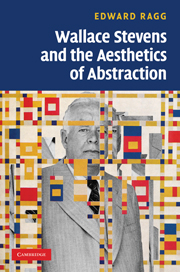Book contents
- Frontmatter
- Contents
- Acknowledgements
- List of Abbreviations
- Introduction: ‘Stevensian’ and the question of abstraction 1935–2009
- 1 The abstract impulse: from anecdote to ‘new romantic’ in Harmonium (1923) and Ideas of Order (1935)
- 2 The turn to abstraction: Owl's Clover (1936) and the ‘un-locatable’ speaker in The Man with the Blue Guitar (1937)
- 3 The ‘in-visible’ abstract: Stevens' idealism from Coleridge to Merleau-Ponty
- 4 Abstract figures: the curious case of the idealist ‘I’
- 5 Abstract appetites: food, wine and the idealist ‘I’
- 6 The pure good of theory: a new abstract emphasis
- 7 Bourgeois abstraction: poetry, painting and the idea of mastery in late Stevens
- Bibliography
- Index
4 - Abstract figures: the curious case of the idealist ‘I’
Published online by Cambridge University Press: 04 August 2010
- Frontmatter
- Contents
- Acknowledgements
- List of Abbreviations
- Introduction: ‘Stevensian’ and the question of abstraction 1935–2009
- 1 The abstract impulse: from anecdote to ‘new romantic’ in Harmonium (1923) and Ideas of Order (1935)
- 2 The turn to abstraction: Owl's Clover (1936) and the ‘un-locatable’ speaker in The Man with the Blue Guitar (1937)
- 3 The ‘in-visible’ abstract: Stevens' idealism from Coleridge to Merleau-Ponty
- 4 Abstract figures: the curious case of the idealist ‘I’
- 5 Abstract appetites: food, wine and the idealist ‘I’
- 6 The pure good of theory: a new abstract emphasis
- 7 Bourgeois abstraction: poetry, painting and the idea of mastery in late Stevens
- Bibliography
- Index
Summary
TAMING ‘THE GUERRILLA I’: THE EARLY POEMS OF PARTS OF A WORLD (1942)
In 1938 Stevens entered one of the most fecund phases of his writing career. With The Man with the Blue Guitar & Other Poems he reached the end of an experimental period, during which he realized abstraction's potential and the poetic possibilities of a novel first-person speaker. If Stevens had not answered his speaker's question in ‘Blue Guitar’ – ‘Where / Do I begin and end?’ – he was certainly more confident about employing this elusive ‘I’ as a speaker, especially in an abstract space. In the poetry following ‘Blue Guitar’ Stevens would break new ground, attracting fewer comparisons with a dandy or Surrealist aesthetic (apart from in the eyes of Cleanth Brooks and Yvor Winters).
Even Picasso's influence on Stevens waned. In 1938, approving a ‘just placing of Picasso’, Stevens copied down Herbert Furst's summary of ‘Guernica’:
Picasso, unfortunately, has made his name pre-eminently as an intellectualist […] [H]is fame rests entirely on his cool and calculated exploitation of the elements of formal design, with or without psychological associations. Away from Nature! was his slogan. Much of his work […] remained, except as a matter of abstract designing, unintelligible. Nevertheless, there has appeared in his oeuvre abstract form, solidly modelled, that had a grim significance of human emotions […] Picasso is not a painter […] he is an over-intellectual designer who moves one to thought, but not to feeling.
- Type
- Chapter
- Information
- Wallace Stevens and the Aesthetics of Abstraction , pp. 110 - 135Publisher: Cambridge University PressPrint publication year: 2010



